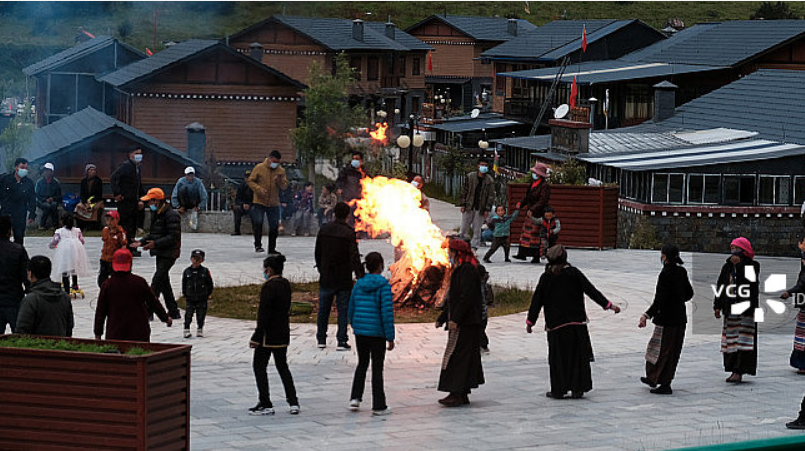Yumai once was the hometown of just one household: Sangye Chopa and his two daughters Drolkar and Yangzom, literally the only three people residing there. In the 1960s, poverty and harsh conditions, like heavy snow, insufficient sunlight and poor infrastructure, drove most residents away.
With a steadfast commitment to safeguarding their ancestral land, Sangye Chopa's family chose to stay. As a result, the responsibility of defending the border naturally fell on their shoulders, and Sangye Chopa became the first person to head the township.
Lives rooted at the frontier
In 1996, officials and doctors assigned by the Central Government breathed new life into this remote high-altitude township. That same year, two new families moved into the township, bringing the local population to 18. Lhaba Tsering's family was one of these new households. What he remembers from his childhood is mostly the long way they'd have to walk to school, battling wind and snow.
For the next two decades, sustained investment and national support slowly began to transform Yumai. That gradual change accelerated dramatically in the 2010s.
Since 2018, the township has advanced the construction of a prosperous border village, with steel-framed houses, drainage systems, schools and parks emerging one after another. In 2019, a state investment of more than 500 million yuan ($70 million) completed the reconstruction of the 50-km paved road linking Yumai with a neighboring township, finally ending its years of seasonal isolation caused by heavy snowfall. In addition, the State Grid Corp. of China extended a 10-kilovolt power transmission line to the township, ensuring stable and reliable electricity supply.
"At first, my whole family huddled in a drafty tent made of yak fur. Later, they moved into a small wooden house," Lhaba Tsering recalled. In 2019, with external support, the family relocated to a newly constructed steel-reinforced house, concluding their reliance on smoky cow dung stoves and ushering in the convenience of bright and warm electric lighting. They also left behind their once-isolated life without phone service or Internet access. By the time the asphalt road was opened to traffic in 2020, all township residents had permanently bid farewell to the practice of wintertime storage. "Finally, mom no longer needed to stockpile supplies for half a year to last us the winter," he added.
Today, what was once a three-person township has grown into a community of more than 250 residents. Its infrastructure has been greatly enhanced, with upgrades to the electricity grid, 5G connectivity, as well as medical and financial service facilities and a border police station.
Data from 2022 indicated that, the township's per-capita annual income at that point had reached nearly 44,000 yuan ($6,155), and the average living space per person was 40 square meters. Additionally, many villagers had turned their houses into family hotels, grocery stores and express stations, among other ventures.
Moving to Yumai from Rerong Township, Lhunze County, in 2019, Sorang Tsering runs a guesthouse. "Summer brings many tourists, and rooms are often in short supply. I'm responsible for transportation, and my wife manages the guesthouse. So that way, our family's annual income exceeds 100,000 yuan ($14,000)," he said.

A bonfire party in Yumai Township in Shannan City, Xizang Autonomous Region, on August 5, 2021
New generations
In 2018, Sangye Chopa's grandson, Sonam Dondrub—Yumai's first university graduate—returned home, foregoing work elsewhere to contribute to the township's development. For him, defending Yumai has become his ultimate duty, following in the footsteps of his grandfather and mother. Just like him, 31-year-old Tenzin Samdrup has been committed to life in Yumai for nearly a decade since graduating from university. He has started a family in this remote highland border region, dedicating his youth to the postal routes across snow-covered mountains.
As for Lhaba Tsering, now serving as an auxiliary officer at a border police station, his greatest wish is to become an immigration management police officer.
In today's Yumai Township, police and local residents form joint teams to conduct border patrols. Their routes often lead them across dramatically steep slopes, some with inclines exceeding 70 degrees. To ascend, they rely on ropes fastened to trees; to descend, they inch forward cautiously, their bodies pressed close to the ground.
Winter or summer, rain or shine, theirs is no easy feat. After heavy rains, for example, the mountains become damp, cold and perilous, with rock surfaces turned smooth and slippery. Patrol personnel must navigate carefully alongside massive boulders, climbing hand over foot. These paths cut through utterly rugged and undeveloped terrain, where moss-covered ground and soft, unstable soil make every step a calculated risk.
But for the local volunteers who organize themselves into teams, patrolling this terrain represents a deep connection with the land. The people here guard the mountains, tend to their livestock, share laughs and songs, and wholeheartedly protect their homeland.
The border of Xizang extends for 4,000 km, and stories similar to those of Yumai have been unfolding along this line. For a long time, most areas here suffered harsh living conditions.
Over the 60 years since the founding of the autonomous region, investment in border areas has steadily increased. Since 2012 in particular, efforts to improve infrastructure—such as water supply, electricity and roads—have been largely strengthened.
As of late 2020, Xizang had established 604 high-standard border villages. Roads in all administrative villages along the border became fully accessible, the main power grid reached every border town and township, postal services extended to every village, and mobile networks achieved full coverage. Safe drinking water for rural residents was secured, while access to public services such as schooling and healthcare grew increasingly convenient.
(Print Edition Title: Defense and Development)


















